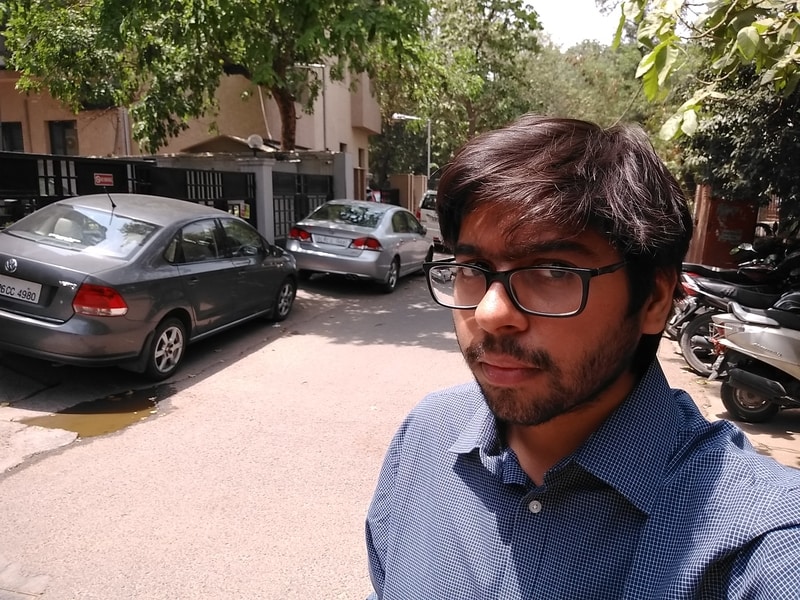
After a rather lean period, Motorola India has kicked off its 2018 innings with the launch of the Moto G6 and Moto G6 Play. The Lenovo-owned company has refreshed the design language of its budget-minded G series and has equipped both smartphones with tall 18:9 displays, which have already become ubiquitous.
We have the Moto G6 in for review, which adds a rear dual-camera setup to the mix and starts at Rs. 13,999 for the variant with 3GB of RAM and 32GB of storage. While past G-series models from Motorola have been received warmly by buyers and critics alike, the Moto G6 is arriving at a time when competition in the sub-Rs. 20,000 market has heated up considerably.
Does the Moto G6 have what it takes to compete with the likes of the Asus ZenFone Max Pro M1(Review), which received top marks from us at Gadgets 360, and the Redmi Note 5 Pro (Review), which has established itself as the segment benchmark? Let’s find out in our full review.
Moto G6 design
With the Moto G6 and G6 Play, Motorola has spurned the plastic and metal bodies of past G-series smartphones for a glass and metal design. With a sleek and shiny curved glass back and a polished metal mid-frame, the Moto G6 looks a lot like last year’s Moto X4 (Review).
At 8.3mm, the phone is not the slimmest out there, but is easy to hold in one hand and is not too heavy (167g). The curves, manageable width, and rounded edges aid one-handed use considerably. However, this smartphone still feels chunky and solid. We (accidentally) dropped it numerous times during our week-long review period, but it did not suffer any damage save for a few cosmetic scratches.
What does worry us a little bit is the fact that Motorola has opted for Gorilla Glass 3 for the front and back, instead of the newer and sturdier Gorilla Glass 4 or 5. The glass makes the device very slippery and prone to fingerprints and smudges. A case is must with this phone.

While most manufacturers have had to move their fingerprint sensors to the backs of their phones in order to accommodate tall 18:9 displays and reduce bezels, Motorola has stuck with a front-facing one. The pill-shaped fingerprint sensor is very small and at first, we weren’t sure how easy it would be to use. Real-world performance however is stellar, and the sensor is very quick and accurate.
The left side of the smartphone is blank, but the right side has the volume rocker and power button. These are small and fiddly, but easily within reach. The earpiece also acts as a speaker, and while it’s loud, the sound it produces lacks warmth and clarity. On the bottom of the Moto G6 is a USB Type-C port and a 3.5mm headphone socket. With many OEMs still using the Micro-USB standard for phones at this price level, it is good to see a Type-C port on both the Moto G6 Play and Moto G6.
Moto G6 specifications and display
Motorola’s newest budget smartphone is powered by the Snapdragon 450 processor, which is Qualcomm’s latest budget offering and is also found inside the likes of the significantly lower-priced Xiaomi Redmi 5 (Review) and Honor 7C (Review). This smartphone is available in two variants – one with 3GB of RAM and 32GB of storage priced at Rs. 13,999, and the one we reviewed here which is priced at Rs. 15,999 and has 4GB of RAM and 64GB of storage. You can expand the storage using a microSD card of up to 128GB.
The Moto G6 has a non-removable 3,000mAh battery and supports quick charging. Connectivity options include 4G VoLTE, Wi-Fi 802.11 b/g/n (dual-band 2.4GHz and 5GHz), Bluetooth 4.2, GPS/ A-GPS, USB Type-C, and a 3.5mm headphone jack. It supports dual SIMs (Nano) but only one can run at 4G speed at a time, with the other limited to 3G. While many smartphones in this price range have hybrid dual-SIM trays, the Moto G6 has dedicated slots for both Nano-SIMs and a microSD card.

With the Moto G6 and Moto G6 Play, Motorola has finally latched on to the 18:9 display trend. The display is not exactly borderless but the presence of a front facing fingerprint sensor compensates somewhat for the relatively chunky bottom bezel.
The Moto G6 features a 5.7-inch full-HD+ IPS panel with an aspect ratio of 18:9. The display is adequate but nothing more. The viewing angles are spot on, and colours are accurate, but sunlight legibility is mediocre and so is the maximum brightness level. The Moto software suite includes a nifty always-on display feature that allows quick replies to messages right from the lockscreen, and a blue light filter.
In our experience, Motorola’s own applications ran fine on the 18:9 display and we were able to stretch third-party applications that do not support this aspect ratio natively.
Moto G6 performance, software, and battery life
We have had mixed experiences with the Snapdragon 450 processor in the past. The Moto G6 however makes optimal use of the hardware that it has. Thanks in part to Motorola’s clean and fluid software package, the G6 handles day-to-day use with aplomb. The phone does exhibit slight lag and stutter, and can heat up a fair bit when tackling intensive workloads. On the other hand, it never slows down too much.
Thanks to the Adreno 506 GPU, the Moto G6 handles games fairly well. We did experience few lags while loading heavy games like Asphalt 8, but gameplay was smooth. Benchmark scores were on par with other smartphones that have the Snapdragon 450, which means phones that cost less than the Moto G6.

The Moto G6 managed a score of 70,060 in AnTuTu, 20fps in GFXbench T-Rex, 5.7fps in GFXbench Manhattan 3.1, and 717 and 3282 respectively in Geekbench’s single- and multi-core tests.
As with most smartphones these days, the Moto G6 has face recognition built in, but it’s slow and inaccurate. In our experience, the Moto G6 simply refused to recognise our face at times, even in favourable lighting.
The near stock build of Android 8.0 Oreo is quick, fluid, and devoid of any laggy overlay. The few additions Motorola has made are genuinely useful and do not take away from the soul of stock Android. What mars the experience somewhat is the presence of a few preinstalled applications, namely Facebook Lite, PhonePe, LinkedIn, and Outlook. While this amount of bloat is minimal (just four applications which can be uninstalled), it sticks out like a sore thumb.

There are the usual Moto Actions such as a chop gesture to turn on the flashlight and double-twist to launch the camera app, which are extremely handy. A feature called Moto Key allows you to enter passwords using your fingerprint. The front-facing fingerprint sensor also facilitates Motorola’s One-Button Nav gesture scheme, which lets you get around the smartphone using only the sensor.
The Moto G6 posted a rather poor score of 8 hours and 40 minutes in our HD video loop battery test. However, real-world performance was actually quite impressive. The phone easily lasted us the whole day, with juice left for more. Our usage involved two hours of navigation using Google Maps, a generous dose of Twitter, WhatsApp and Facebook, games such as Asphalt 8 and Subway Surfers, and taking a dozen or so selfies and pictures.
Motorola ships a 15W Turbo Charger in the box, which charged the phone fully in less than 1.5 hours. The smartphone does get quite hot while charging, to the point that it is uncomfortable to hold.
Moto G6 cameras
The Moto G6 has a dual rear camera setup comprising of a 12-megapixel primary sensor and a 5-megapixel secondary sensor. At the front, the Moto G6 has a 16-megapixel sensor. There is a dual-LED flash at the rear and a single-LED flash at the front.
The camera app offers a multitude of features such as a Text Scanner mode that converts an image of text to actual text, and a Spot Color mode that lets users retain colour on only one object while turning the rest of the photo monochrome. Both come across as gimmicks, with the Spot Colour mode in particular proving to be quite buggy. There is also a fully featured Pro Mode which allows you to adjust the white balance, ISO, exposure, and shutter speed.




Tap to see full-sized Moto G6 camera samples
Both the front and rear cameras are average at best. Images taken with the rear camera at night are dark and muddy, and have a lot of noise. The camera also over-sharpens images in a bid to control noise.
Shots taken in favourable light have accurate colours but are not as detailed as we would have liked. The dynamic range is also slightly disappointing. Portrait mode allows for the capture of shots with depth-of-field effects, which are sub-standard with poor edge detection around objects. The blur effect is also not very effective.
Selfies follow much the same script. The front camera performs adequately when lighting is favourable but struggles in low light. The camera tends to overexpose shots in direct sunlight. The front LED flash does help slightly. Video capture maxes out at 1080p for both the front and rear camera. Motorola’s EIS does a good job in keeping videos stable, but the level of detail is lacking.

Moto G6 in pictures
Verdict
The Moto G6 looks absolutely stunning, is compact and easy to hold with one hand, and offers good battery life. Performance is decent, and the display has accurate colours but is difficult to use in bright sunlight. That said, the cameras are distinctly average, and face recognition is slow and inaccurate.
The Moto G6 is priced incredibly close to the the Xiaomi Redmi Note 5 Pro (Review) and Asus ZenFone Max Pro M1 (Review) which are more powerful and have a better set of cameras. The more affordable Xiaomi Redmi Note 5 (Review) shares many of its specifications with the Moto G6, which makes it better value for money. Potential buyers could also take a look at the recently launched Realme 1 (Review), which has more power under the hood but lacks a fingerprint sensor and has an average set of cameras.
For the latest tech news and reviews, follow Gadgets 360 on Twitter, Facebook, and subscribe to our YouTube channel.
[“Source-gadgets.ndtv”]












